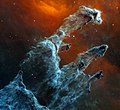File:Pillars of creation - JWST, MIRI - STScI-01GFRYYRTCTMX197BY86MBFCR9.png

Size of this preview: 656 × 600 pixels. Other resolutions: 263 × 240 pixels | 525 × 480 pixels | 840 × 768 pixels | 1,120 × 1,024 pixels | 1,987 × 1,817 pixels.
Original file (1,987 × 1,817 pixels, file size: 4.06 MB, MIME type: image/png)
File history
Click on a date/time to view the file as it appeared at that time.
| Date/Time | Thumbnail | Dimensions | User | Comment | |
|---|---|---|---|---|---|
| current | 21:06, 29 October 2022 |  | 1,987 × 1,817 (4.06 MB) | Fabian RRRR | Uploaded a work by Credits: SCIENCE: NASA, ESA, CSA, STScI IMAGE PROCESSING: Joseph DePasquale (STScI), Alyssa Pagan (STScI) from https://webbtelescope.org/contents/media/images/2022/053/01GFRYSFM89AFADVAA0W625BSB with UploadWizard |
File usage
The following pages on the English Wikipedia use this file (pages on other projects are not listed):
Global file usage
The following other wikis use this file:
- Usage on da.wikipedia.org
- Usage on de.wikipedia.org
- Usage on es.wikipedia.org
- Usage on fr.wikipedia.org
- Discussion utilisateur:O. Morand
- Discussion utilisateur:Padawane
- Discussion utilisateur:L'amateur d'aéroplanes
- Discussion utilisateur:Sammyday
- Discussion utilisateur:Oziris
- Discussion utilisateur:Pautard
- Discussion utilisatrice:Esprit Fugace
- Discussion utilisateur:Ghoster
- Discussion utilisateur:Hadrianus
- Discussion utilisateur:GabrieL
- Discussion utilisateur:Borvan53
- Discussion utilisateur:Theoliane
- Discussion utilisateur:Abalg
- Discussion utilisateur:Michel421
- Discussion utilisateur:Kimdime
- Discussion utilisateur:Cantons-de-l'Est
- Discussion utilisateur:A1AA1A
- Discussion utilisateur:Hégésippe Cormier
- Discussion utilisateur:Erik Bovin
- Discussion utilisatrice:Manacore
- Discussion utilisatrice:Gráinne Ni Mháille
- Discussion utilisateur:K.A
- Discussion utilisateur:Skimel
- Discussion utilisateur:ContributorQ
- Discussion utilisateur:Mandariine
- Discussion utilisateur:HMa
- Discussion utilisateur:Bertrouf
- Discussion utilisateur:O-R/Archive
- Discussion utilisateur:Lagribouille
- Discussion utilisateur:Jean-Paul Corlin
- Discussion utilisateur:Tylwyth Eldar
- Discussion utilisateur:Starus
- Discussion utilisateur:Sunrise156
- Discussion utilisateur:O.Taris
- Discussion utilisateur:Ælfgar/6649
- Discussion utilisateur:Sernin seb-calmetaf
- Discussion utilisateur:Bounè rodzo
- Discussion utilisateur:Goodshort
- Discussion utilisateur:Polmars
- Discussion utilisateur:BerwaldBis
- Discussion utilisateur:GrandCelinien
- Discussion utilisateur:Olivier Tanguy
- Discussion utilisateur:Jack Rabbit Slim's
- Discussion utilisateur:Io Herodotus/Archive 2021-2023
- Discussion utilisateur:Julien1978/Archive 7
- Discussion utilisateur:Harrieta171/1
- Discussion utilisateur:SenseiAC
View more global usage of this file.




